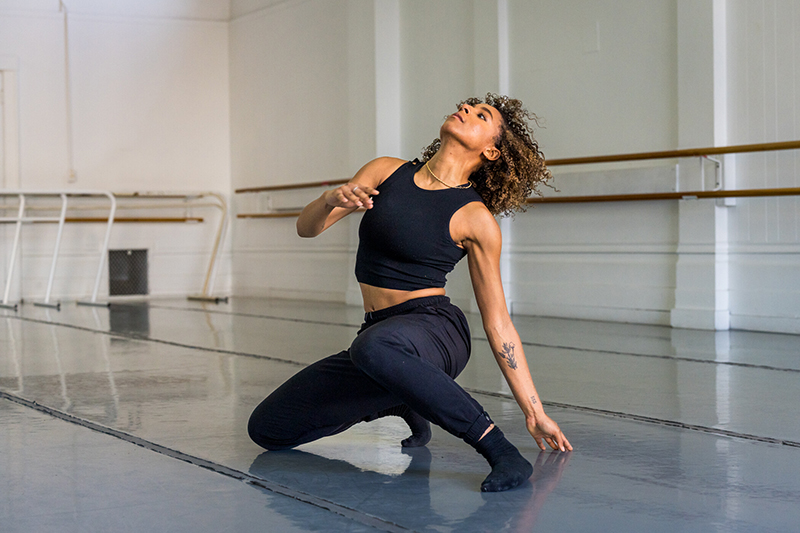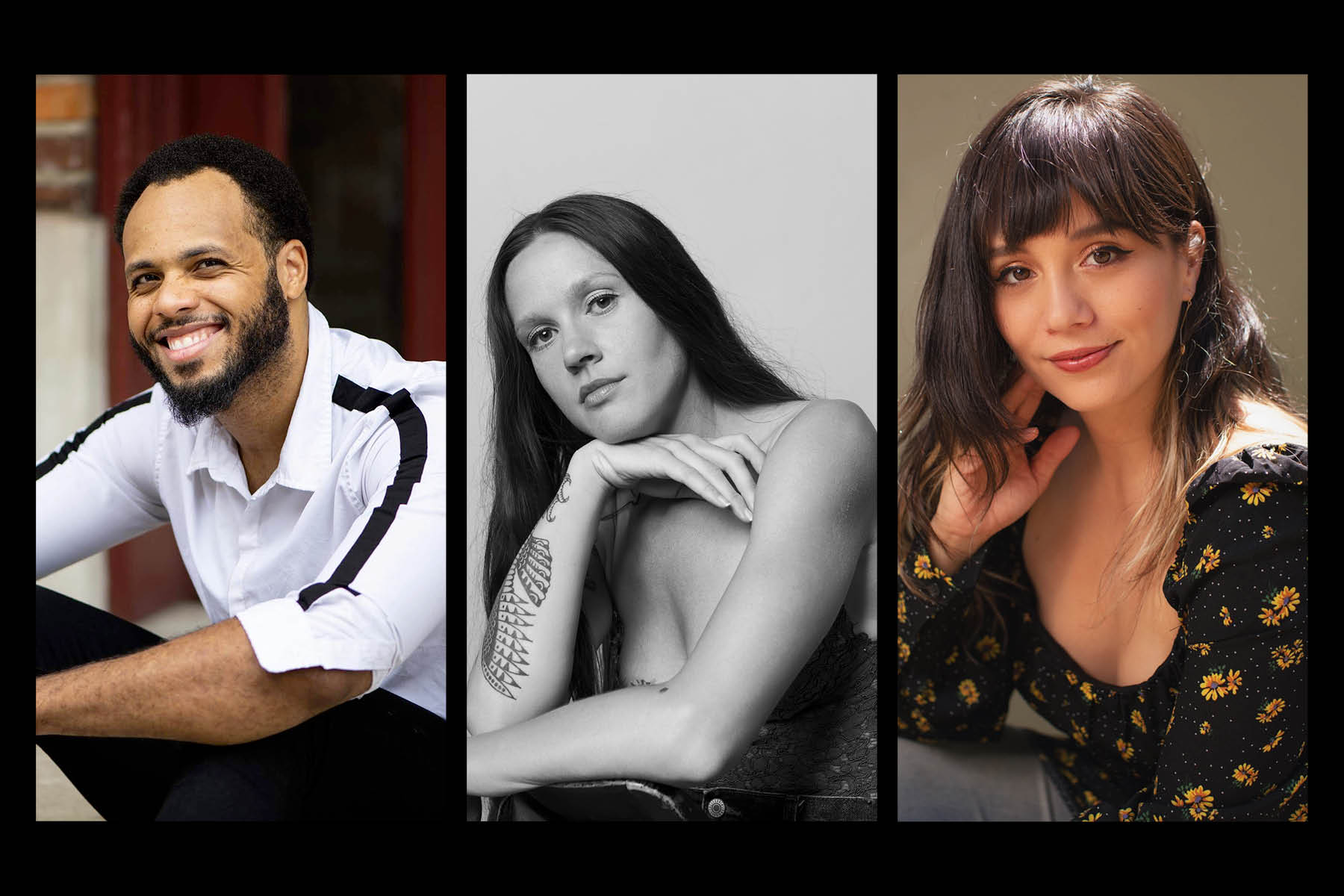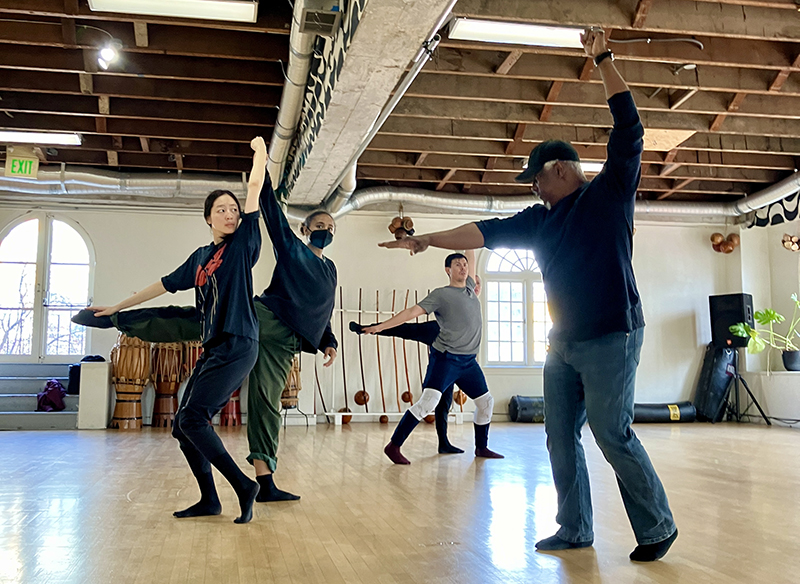Ephemeral Anthologies
An Interview with Robert Moses and guest choreographers Natasha Adorlee, Khala Brannigan, and Robert S. Kelley II
BY EMMALY WIEDERHOLT
Robert Moses is a Bay Area-based choreographer and the director of Robert Moses’ KIN. In the company’s upcoming shows, New Legacies: One Act Dances, the company is commissioning a collaborative triptych by bringing on three guest choreographers, three guest composers, and three guest writers. Guest choreographers Natasha Adorlee, Khala Brannigan, and Robert S. Kelley II have been tasked with creating a work in response to the growing global impulse toward silence and censorship. Here, Robert Moses speaks about how he’s approaching this project as an anthology, and the guest choreographers share what this subject matter means to them.
Performances are March 15-17 in San Francisco.

Z Jackson, Photo by Steve Disenhof
~~
Robert Moses, what is some of the driving motivation for your upcoming season that focuses on issues of silence and censorship?
Robert Moses: It wasn’t one thing. There are a lot of what seem to be unrelated things happening. One of the things is the controversy around Critical Race Theory. I read Derrick Bell, who would have been considered a seminal CRT author. What I was hearing about what it was and what it was trying to do was completely out of line with what I had read years ago. I thought it was ridiculous. Everything else over time has been bubbling up with teachers and book bans all over the country and specifically in Florida where I have family. It became about freedom and expression.
You’ve selected three choreographers as well as three composers and writers to create work on the subject of silence and censorship for this upcoming show. Why did you select Natasha Adorlee, Khala Brannigan, and Robert S. Kelley II as guest choreographers?
Robert Moses: There are a lot of pieces to this. There was a panel that selected the choreographers. The panel made the selection, and I made the final selection. It ended up being two folks who had already worked with the company in one way or another.
It’s part of an anthology of work. We have multi-year support to make a series of works over three to five years about the same subject. This year is censorship and educational freedom. That’s the subject everyone is working on, but like an anthology, they don’t have to approach it the same way.
I’m trying to come up with different models for making and sharing work. Often what happens is you make a work once and then it is done unless you can get those folks together again or get another presentation of it. I was trying to find a way around that. What’s happening with this work is all the artists in the triptych have access to the other material in the work. In that way, the three works (plus the compositions and writings) have the potential to be several works because everyone has agency in the context of all that work. If I made dance A but am interested in the same subject matter, I have access to dance B and C and can move forward. Of course, the pieces are credited as the original generating party. Ideally, each component could have multiple lives.
Natasha, Khala, and Robert Kelley, how did you get involved in this collaboration with Robert Moses’ KIN?
Natasha: My involvement in this collaboration stems from a professional interest and a personal connection. When I stumbled upon the open call with Robert Moses’ KIN, I was immediately drawn to the aspect of collaboration, which resonates deeply with my artistic sensibilities. Having previously danced with Robert Moses, the prospect of rekindling that creative partnership was exciting as my time with Robert was profound.
Khala: At the start of 2024, I decided to get really clear about what I wanted my life to look like as an artist. Commissions are an ideal source of income as a choreographer for many reasons, so I gathered all my materials and sent them to at least 30 dance colleges and dance companies, Robert Moses’ KIN being one of them. I had no expectations of getting any responses, I just wanted to put it out into the universe to see what happened. When I got a response from Robert about this project, I was thrilled. The San Francisco Bay Area supported my early career as an artist for eight years, and after dancing for Robert Moses’ KIN from 2017-2019, I relocated to New York City to continue my pursuits as a choreographer. I’m excited to come back to my roots while also being pushed outside my comfort zone during this collaboration.
Robert Kelley: I received a phone call from Mr. Moses in mid-December 2023 about how he was putting this project together and asked me to submit some work samples to be considered. In late January, I received another call from Mr. Moses inviting me to join the collaboration.

Left: Robert Kelly, photo by Amanda Van Meter Burch; Middle: Khala Brannigan, photo by Edon Gottlieb; Right: Natasha Adorlee, photo by Robert Suguitan
How do the issues of censorship, silence, literacy, and denial resonate with you personally?
Natasha: The intersection of these topics is a vast and complex terrain that I find both intellectually stimulating and emotionally resonant. Through my journey in dance, I’ve come to understand the transformative power of accessibility in both performance and education. This understanding has fueled my commitment to creating avenues for broader engagement with dance, ultimately striving to dismantle barriers that inhibit the flow of information. For me, these issues are not just theoretical concepts; they represent tangible obstacles that, when overcome, have the potential to enrich our collective humanity. We can foster a more enlightened and interconnected society by championing the liberation and preservation of information.
Khala: Of course, I have always feared failure or rejection by expressing my authentic self. I wouldn’t be human if I didn’t. Especially nowadays, every word and action are being accounted for, yet we are bound to make mistakes as we strive for systemic changes. On a personal level, I have been constantly fighting against familiar belief systems and trying to return to the ancestral wisdom and intuition that lies within my body, no matter how challenging that may be. My experiences throughout life have created armor, a protection from harm so I can feel safe; yet my work as an artist juxtaposes that comfort and safety. I am challenged to let my guard down and expose the inner workings of my mind, body, and spirit when I am in a creative process. There have always been two parts of me opposing one another: one part has something important to say and wants it to be known, and the other part that wants comfort, safety, silence, and control. As these two parts battle each other on a daily basis, I can recognize that failure and rejection are an inevitable part of this journey as an artist.
Robert Kelley: Censorship in particular has always been a hot button for me. As someone who has a stutter, how one chooses to communicate and express themselves has become increasingly important to me. I am someone who firmly believes that freedom of expression should be just that. I believe that censorship is a means to curtail the masses, a device that can be harmful. I understand that there can be a morale behind why certain people or groups choose to censor (i.e. age-appropriate music, etc.), but even in those cases and others, the choice to censor is typically made by those who are the majority or in positions of power and that is where I find fault in the act because who are they to limit and filter expression?
What is your choreographic process?
Natasha: My choreographic process is a multifaceted exploration that draws inspiration from physicality, music, and the art of world-building. At its core, I envision each dance work as a microcosm, meticulously crafted to evoke a sense of place and time. I revel in weaving together various elements, from movement vocabulary to thematic narratives, to construct a cohesive, immersive universe within the performance space. This holistic approach allows me to channel my passion for complexity and cohesion.
Khala: When I am in a creative process, I aim to retrieve the parts of self that may have been lost due to oppression or living in a toxic society, cultivating a space to rebel against any myths of ‘normal.’ After spending years training in classical forms of dance, my work continues to be highly technical and athletic, simultaneously taking risks through improvisation and spontaneity, and finding joy in connection with others. I typically already have a world created in my mind before I enter the studio and begin the creative process. I know what I want the world to feel like, taste like, sound like. I spend a lot of solo time in the studio generating movements and ideas before I incorporate other dancers and collaborators so that I have a personal connection to the work. The clarity I cultivate before rehearsals even begin creates a backbone that I can always return to throughout the process, and also allows freedom for conversations with my collaborators. Eventually, the work evolves into something bigger than me and my choreography, and becomes a life of its own.
Robert Kelley: My process starts from building an emotional connection between the subject matter and how it can be expressed through the body. I then build motifs to create a series of tableaux that morph from one to another using dance improvisation. My process is highly collaborative; I ask my dancers to follow their impulse as I give them prompts to draw from while they learn movement. This allows me to be influenced by new movement vocabulary that can be incorporated into the dance.
Robert Moses, you’re also showing a new piece, A Cleaning Woman’s Reflection on Creation. What was the impetus behind this piece and what has been your choreographic process?
Robert Moses: I made a piece last year called Fugitive Literacies dealing with the same subject matter. This piece also deals with it, though it’s not in the triptych in the way the others are. I’ve been writing a lot asking: How do you lose your voice? How does fear operate in academia if you’ve been told you can’t teach Mark Twain in the particular way you’ve been teaching it for 20 years? It’s also connected to things like African Americans losing a finger or being beaten because they were carrying a spelling book. It’s all tied up in things you can or cannot say, who has the power to stop your voice, and what that means to stop a voice.
My process is I’ll stuff myself with as much information as possible. There are a number of books I’ll read or an online course or two I might take. I’ve been reading Self-Taught about self-education in African American communities, or Red Lines about political cartoons. I take notes and see how I feel about them. I write down the parts I’m most interested in, my feelings, and some physical impulses. What does it psychologically feel like? I word map those things, so that one thing connects to another in not necessarily such a direct manner as it was when it was on the page. I go into the studio and come up with movement attached to some aspect of the emotional or psychological feeling, and then map it onto the dancers or bring the text to them. If the movement generation is working, I find movements that are emotionally resonant and physically compelling.
Why is it important to make dances about social issues like censorship? How can dance impact or add to the conversation about these issues?
Robert Moses: Different forms can carry different weight. Dance is literate but not literary. It’s not writing. You don’t feel about it the same way as something on the page. It cannot carry that weight.
Folded into your questions is: How do I put this idea on that body? The other side of that question is: How do I get that body to communicate the idea with the audience? The answer is: It is only what it is. But there’s a lie that’s been going around about art and protest. It is only what it is. But I can with my intention design something as clear as I can make it and remove the notion of interpretation from the equation. I may or may not get to the place where I can communicate my idea, but it will never be someone standing in front of a tank in Tiananmen Square. It can be a representation, an analogy, or a metaphor for those things, and that metaphor can move you. The lynchpin in the whole conversation is you. It communicates as much about you. If you have a conversation about it, then it might catalyze you to stand in front of a tank or to be gassed in a protest or write a letter or go vote. The art is only what it is. The person is affected in some way, and then if that person is so moved, they go and do something. That’s a weight that we’ve been putting on art for a long time that it can’t bear, even if the art is social protest.
I understand this is part of ongoing work about silence and censorship. Do you have a sense of what’s beyond this show?
Robert Moses: I’ve been working on this for some time. I think the notion of the anthology is interesting to me. It’s iterative in the moment and refers to itself in the moment. It compliments or compares or denies itself in the moment. If you read an anthology, it’s notions of aspects of the thing that will deepen your relationship to that subject matter, rather than reading just one essay. The depth of this comes from the multiple iterations of the notion of some aspect of it.

Photo courtesy Robert Moses’ KIN
~~
To learn more, www.robertmoseskin.org.
